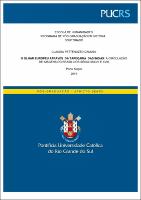| Share record |


|
Please use this identifier to cite or link to this item:
https://tede2.pucrs.br/tede2/handle/tede/8914| Document type: | Tese |
| Title: | O olhar europeu através da tapeçaria das índias : a circulação de imagens do Brasil nos séculos XVII e XVIII |
| Author: | Damiani, Claudia Pettenuzzo  |
| Advisor: | Monteiro, Charles |
| Abstract (native): | No século XVII, com a ocupação de parte do território brasileiro pela Companhia das Índias Ocidentais holandesa, um processo planejado de registro artístico e etnográfico iniciou-se, com a vinda de artistas como Albert Eckhout (1610–1665) e Frans Post (1612–1680). Entre 1637 e 1644, produziu-se um acervo considerável transportado à Europa pelo governante e patrocinador Conde Maurício de Nassau (1604–1679). Estabelecida a circulação de imagens do Brasil holandês na Europa, tais obras e outros objetos do acervo material foram expostos ou distribuídos para as casas reais e a nobreza. O trânsito de tais imagens ocorreu dentro de um circuito que era permeável a imagens de outras procedências, inclusive africana. As imagens foram reproduzidas em gravuras e livros de viajantes, ganhando novos suportes e versões em terras europeias. Tapeçarias produzidas na França receberam os temas brasileiros (ou das Índias). O processo da circulação das imagens que vieram a compor a Tapeçaria das Índias é o objeto central desta tese. As referidas tapeçarias, produzidas pela Manufatura dos Gobelins, encontram-se em séries: Anciennes Indes (1687), confeccionada com pinturas atribuídas a Albert Eckhout; e Nouvelles Indes (1735), com pinturas de Alexandre-François Desportes (1661–1743), que realizou uma releitura da versão original. As tapeçarias, seus antecedentes e a contextualização de sua produção são o pano de fundo para o eixo da investigação sobre a circulação das imagens, suas funções e migrações. Para isso, trabalhou-se um corpus de imagens: as que antecederam a representação do Brasil (ou das Índias) na Tapeçaria das Índias; os cartões (modelos) da Tapeçaria das Índias; e a Tapeçaria das Índias como produto final. A Tapeçaria das Índias é portadora de imagens de conhecimento e circulação global manifestadas por meio dos motivos exóticos de terras de fora da Europa, apesar de ter como base um retrato da natureza brasileira do século XVII. Isso não ocorreu somente porque tais imagens sofreram adaptações e compilações, mas também porque as próprias imagens geradoras têm uma historicidade, isto é, estão conectadas em redes visuais e sofrem transformações. Para atender à tese, a pesquisa aborda três eixos norteadores, que foram desenvolvidos ao longo de todos os capítulos: a visão europeia sobre o Brasil/Índias; a autoria das imagens da Tapeçaria das Índias; e a circulação das imagens. |
| Abstract (english): | In the seventeenth century, with the occupation of part of the Brazilian territory by the dutch’s West Indies Company, and the arrival of artists such as Albert Eckhout (1610-1665) and Frans Post (1612-1680) a planned process of artistic and ethnographic record began. Between the years of 1637 and 1644, a considerable collection of artifacts and artistic works was transported to Europe. This collection, was arranged during the rule of its sponsor Count Maurice of Nassau (1604-1679). Once the circulation of images of Brazil in Europe began, such works and other objects of the material collection were exhibited or distributed to the royal houses and the nobility. The transit of such images occurred within a permeable circuit to other image sources, including African. The images were reproduced, in engravings and travelers' books, thus gaining new supports and versions upon arrival in Europe. Tapestries produced in France received Brazilian (or Indian) motifs. The process of circulation of the images that came to be part of the Tapestry of the Indies is the central object of this thesis. These tapestries, produced by the Gobelins Manufacture, can be found in series: Anciennes Indes (1687) made with paintings attributed to Albert Eckhout and Nouvelles Indes (1735) with paintings by Alexandre-François Desportes (1661-1743) who carried out an adaptation of the original version. The tapestries, their antecedents and the contextualization of their production are the background for the analysis on the circulation of images, their functions and migrations. For that, a corpus of images was focused: those that preceded the representation of Brazil (or the Indies) in the Tapestry of the Indies; the cartons (models) of the Tapestry of the Indies and; the tapestries of the Indies as a final product. In theory, this was not only due to the fact that such images received adaptations, compilations (according to the interests of the aristocratic Europe, and directed by the French crown), but also because the original Dutch images themselves have historicity. They are connected in visual networks and undergone transformations. In order to develop the thesis, the research, was based in three guidelines, that were developed throughout all chapters: the european view on Brazil/Indies, the authorship of the images of the Tapestry of the Indies and the circulation of images. |
| Keywords: | Tapeçaria das Índias Albert Eckhout História da Arte Cultura Visual Circulação de Imagens Brasil Colonial Tapestry of the Indies Albert Eckhout Circulation of Images Art History Visual Culture Colonial Brazil |
| CNPQ Knowledge Areas: | CIENCIAS HUMANAS::HISTORIA |
| Language: | por |
| Country: | Brasil |
| Publisher: | Pontifícia Universidade Católica do Rio Grande do Sul |
| Institution Acronym: | PUCRS |
| Department: | Escola de Humanidades |
| Program: | Programa de Pós-Graduação em História |
| Access type: | Acesso Aberto |
| Fulltext access restriction: | Trabalho será publicado como artigo ou livro |
| Time to release fulltext: | 48 meses |
| Date to release fulltext: | 03/10/2023 |
| URI: | http://tede2.pucrs.br/tede2/handle/tede/8914 |
| Issue Date: | 22-Aug-2019 |
| Appears in Collections: | Programa de Pós-Graduação em História |
Files in This Item:
| File | Description | Size | Format | |
|---|---|---|---|---|
| TES_CLAUDIA_PETTENUZZO_DAMIANI_COMPLETO.pdf | CLAUDIA_PETTENUZZO_DAMIANI_TES | 14.26 MB | Adobe PDF |  Download/Open Preview |
Items in DSpace are protected by copyright, with all rights reserved, unless otherwise indicated.




